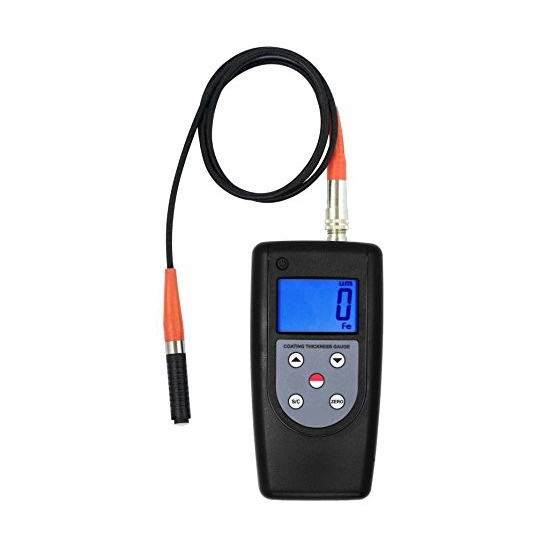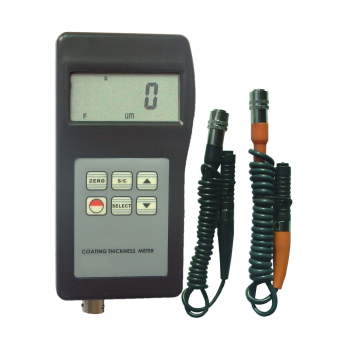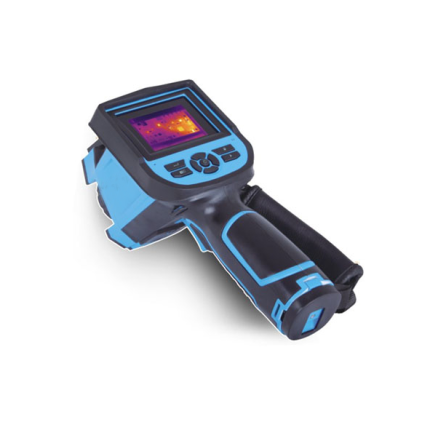Description
Overview
GAOTek High Accuracy Coating Thickness Meter (2 Measuring Method) is designed for thickness measurement of magnetic and non-magnetic materials using single mode and continuous mode with the resolution of 0.1 µm. The F probe measures the thickness of non-magnetic materials on magnetic materials and the N probe measures the thickness of non-magnetic coatings on non-magnetic metals. It is used on anodizing, varnish, paint, enamel, plastic coating, etc. It is also applied to aluminium, brass, non-magnetic stainless steel etc. This coating thickness meter communicate with PC computer using the cable and stores the data in the PC for future analysis. . It comes with a 4 digits LCD display and uses 4 x 1.5 AAA batteries. It can be used both in the laboratory and in harsh field conditions. It meets the standards of both ISO2178 and ISO 2361.
Key Features
- Manual or automatic shutdown.
- Two measurement mode: Single and Continuous
- Wide measuring range and high resolution.
- Digital backlit display which gives accurate reading
- Can communicate with PC computer for statistics and printing by the optional
- Selectable Metric/Imperial system.
- The F probes measure the thickness of non-magnetic materials
- The N probes measure the thickness of non-magnetic coatings on non-magnetic metals.
- It meets the standards of ISO2178 and ISO 2361 as well as DIN, ASTM and BS.
- It can be used both in the laboratory and in harsh field conditions.
- Automatic memory of calibration value, and automatic recognize the substrate.
- Operation process have buzzing reminder
- Use “USB data output” and “RS-232 data output” to connect with PC
- Provide “Bluetooth ™ data output” choice.
Technical Specifications
| Operating Principle | Magnetic Induction (F) / Eddy Current (NF) |
| Display | 4 Digits LCD, backlit |
| Measuring Range | 0 ~ 2000 μm / 0 ~ 8 mil |
| Resolution | 0.1 μm (0 ~ 99.9 μm) / 1 μm (over 100 μm) |
| Min Radius Work-piece | F Type: convex 0.06 in (1.5 mm) / concave 0.98 in (25 mm) NF Type: convex 0.12 in (3 mm) / concave 1.97 in (50 mm) |
| Min Measuring Area | 0.24 in (6 mm) |
| Min Sample Thickness | 0.01 in (0.3 mm) |
| Accuracy | ± 1 ~ 3 % n or ± 2.5 um |
| Power Off | Auto Power Off |
| Metric / Imperial | Convertible |
| Battery Indicator | Low Battery Indicator |
| Operating Temperature | 32 °F ~ 104 °F (0 °C ~ 40 °C) |
| Humidity | 10 ~ 90 % RH |
| PC Interface | With RS-232C interface |
| Power Supply | 4 x 1.5 V AAA (UM-4) Battery |
| Dimensions | 5.5 in x 2.8 in x 1.3 in (140 mm x 72 mm x 34 mm) |
| Weight | 0.47 lbs. (215 g) (Without batteries) |
Additional Information
Standard accessories:
- Carrying case -1 pc.
- Operation manual – 1 pc.
- F/NF probe – 1 pc.
- Calibration foils -1set.
- Substrate (Iron) -1 pc.
- Substrate (Aluminum) – 1 pc
Optional accessories:
- USB, RS-232C cable & software.
- Bluetooth data output & software
Front Panel Descriptions

3-1 Jack forRS232C
3-2 Display
3-3 Plus Key
3-4 μm / mil Conversion Key
3-5 Single / Continuous Key
3-6 Minus Key
3-7 F / NF Conversion Key
3-8 Zero Key
3-9 Power Key
3-10 Probe
MEASURING PROCEDURE
- Press the power key to switch on the power and ‘0’ displays on the Display. The gauge will restore the last operation on display itself, with ‘Fe’ or ‘NFe’ symbol showed on Display.
- Press the probe on a coating layer to be measured. The reading on the display is the thickness of the coating layer. The reading can be corrected by pressing the Plus key and minus key while the probe is away from the substrate or the measured body.
- To take the next measurement, just lift the probe to more than 1 centimeter and then repeat the step above.
- If suspecting the accuracy of measurement, you should calibrate the gauge before taking the measurements. For the calibration procedures, please refer to the calibration part.
- The gauge can be switched off by pressing the Power key. On the other side, the gauge will power itself off about 50 seconds after the last operation.
- To change the measurement unit ‘μm’ or ‘mil’ by
- Depressing the μm/mil Convert Key
- Depressing Power key and not releasing it till ‘UNIT’ on the Display and then pressing Zero key (3-6).
- To change measurement mode from the single to continuous or vice visa, just by
- Depressing the Single/Continuous Key.
- Depressing Power key and not releasing it till ‘SC’ on the Display and then pressing Zero key (3-6). The measurement mode is the continuous mode if a symbol ‘
 ’never disappears on the display. Otherwise it is in a single measurement mode if ‘
’never disappears on the display. Otherwise it is in a single measurement mode if ‘ ’ only appears for a while every time taking a measurement.
’ only appears for a while every time taking a measurement.
CALIBRATION
- Zero adjustment for ‘Fe’ and ‘NFe’ should be carried out separately. Take the iron substrate if ‘Fe’ on Display, while take the aluminum substrate if ‘NFe’ on the Display. Place the probe (3 – 10) on the substrate steadily. Press the zero key (3-8) and ‘0’ will be on the Display before lifting the probe. If pressing the ZERO key but the probe is not placed on the substrate or an uncoated standard. The zero adjustment is invalid.
- Select an appropriate calibration foil according to your measurement range.
- Place the standard foil selected onto the substrate or the uncoated standard.
- Place the sensor (3-10) mildly onto the standard foil and lift. The reading on the display is the value measured. The displayed reading value can be adjusted by pressing the plus key (3-3) or minus key (3-6) while the probe is away from the substrate or the measured body.
- Repeat step 4 until the result is correct.
BATTERY REPLACEMENT
- When it is necessary to replace the battery, the battery symbol ‘
 ‘ will appear on the Display.
‘ will appear on the Display. - Slide the Battery Cover away from the instrument and remove the batteries.
- Install the batteries (4 x 1.5 V AAA / UM-4) correctly into the case.
- If the instrument is not to be used for any extended period, remove batteries.
CONSIDERATIONS
- In order to weaken the influence of the measured material on the accuracy of measurement, it is recommended that the calibrations should be done on the uncoated material to be measured.
- Probes will eventually wear. Probe life will depend on the number of measurements taken and how abrasive the coating is. Replacement separate can be fitted by qualified persons only.
RESTORE FACTORY SETTINGS
When to restore?
It is recommended to restore factory settings in the one of following cases.
- The gauge does not measure any more.
- Measurement accuracy is degraded caused by environmental conditions change greatly.
How to restore?
- Restore factory settings includes ‘Fe’ setting and ‘NFe’ setting. You can restore one of them or both of them respectively. Please follow procedures below to restore factory setting
- Please note the symbol on the display is ‘Fe’ or ‘NFe’. If ‘Fe’ is on the display, the operation below is restoring the factory setting for ‘Fe’ type, and if ‘NFe’ is on the display, the operation below is restoring the factory setting for ‘NFe’ type.
- Depress Power key and not release it till ‘CAL’ appears on the Display. It is about 12 seconds from starting to depress Power key.
- When F:H or nF:H is on Display, lift the probe to more than 5 centimeters, then press the Zero key again and the gauge return to measurement state. The factory setting is restored. Remember, to restore factory setting should be done within 6 seconds at every stage or the gauge will quit itself and restoration is invalid.
Notes
- Settings includes restoring factory setting, unit setting, S/C setting, which should be done within 6 seconds at every stage, or the gauge will quit itself and keep its status before.
- It is strongly recommended that no changes should be made to the value of Ln (controlled by power key. It takes about 14 seconds from starting depressing Power key. Its value can be changed by plus/minus key after displaying Ln and releasing the power key. Store its value and quit by pressing Zero key) which will seriously affect the accuracy. Its value can be adjusted by professional persons only under the cases of replacing a new probe or making the gauge more accurate. Generally, larger the value of Ln, smaller will be the reading on a same thickness. A little variation of value of Ln will cause a great change in reading at high end (e.g. at 500 μm / 20 mil). The rules to adjust the value of Ln are as follow:
- Reading at low end can be adjusted to the exact value by the plus or minus key.
- To enlarge the Ln if reading at low end is ok but reading at high end is too large. On the contrary, to decrease the Ln if reading at low end is ok but reading at high end is too small.
- Repeat procedures from A to B till the readings on the every standard foil are satisfying the accuracy.



